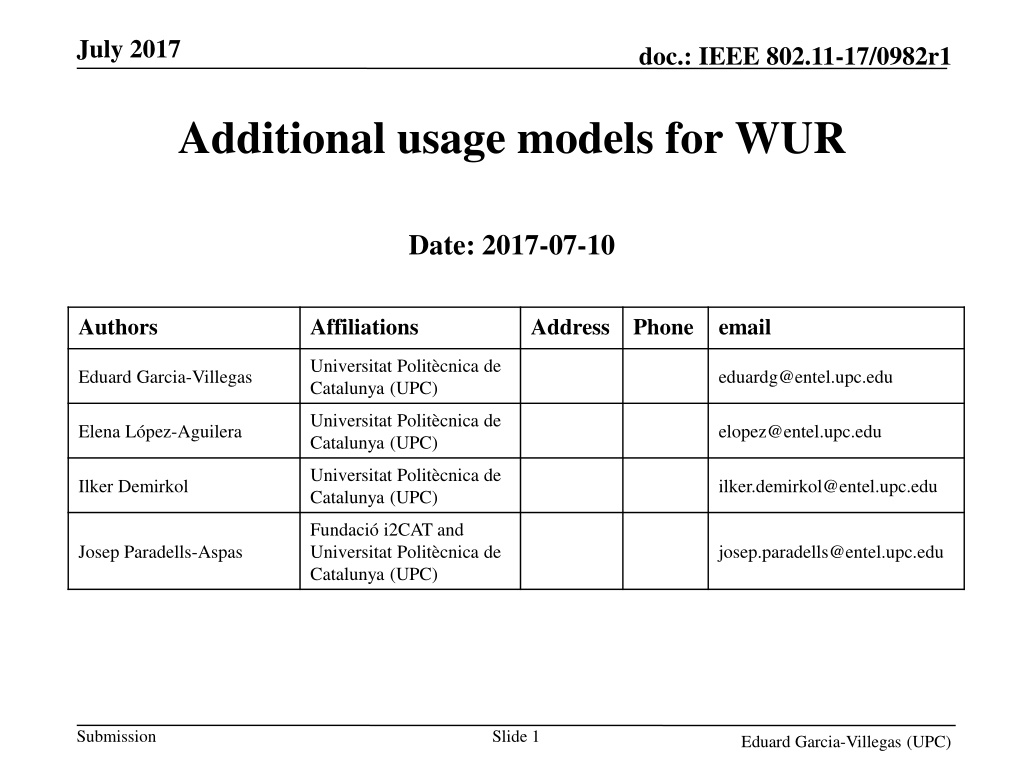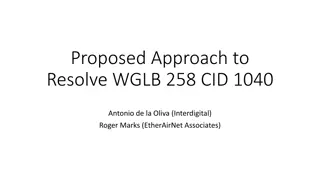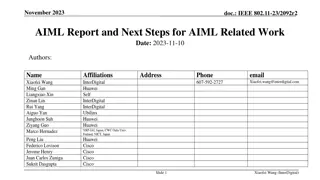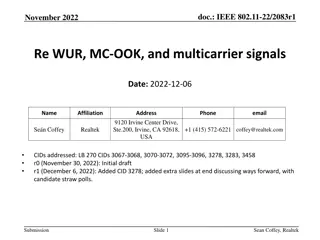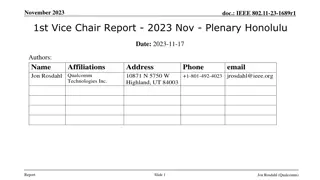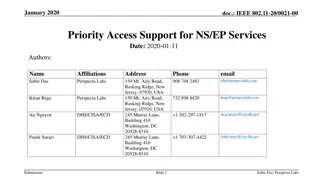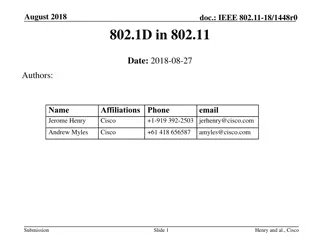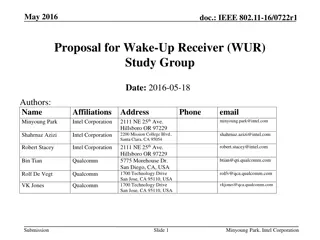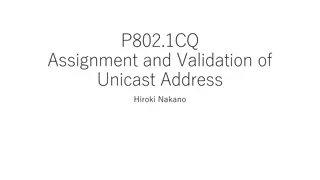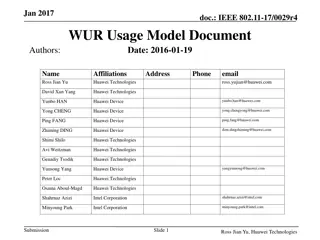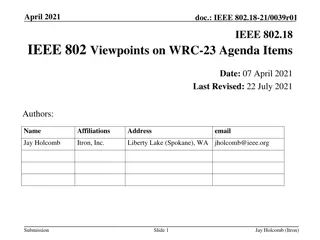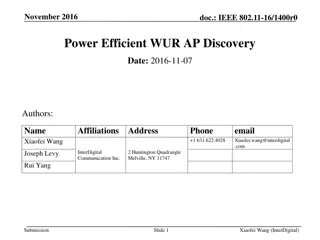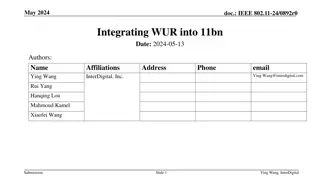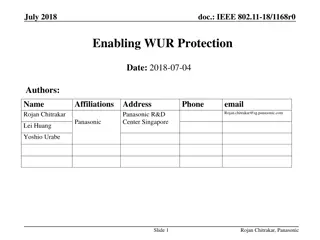Additional Usage Models for WUR in IEEE 802.11-17
This document discusses additional usage models for Wake-Up Radio (WUR) in the context of IEEE 802.11-17 standard. It explores new scenarios such as Smart Homes, Warehouse setups, and Sensor Network Wake-Up mechanisms. The proposed Wake-Up Access Point (AP) model aims to enhance energy savings, reduce interference, and improve security in domestic and small-office/home-office environments.
Download Presentation

Please find below an Image/Link to download the presentation.
The content on the website is provided AS IS for your information and personal use only. It may not be sold, licensed, or shared on other websites without obtaining consent from the author.If you encounter any issues during the download, it is possible that the publisher has removed the file from their server.
You are allowed to download the files provided on this website for personal or commercial use, subject to the condition that they are used lawfully. All files are the property of their respective owners.
The content on the website is provided AS IS for your information and personal use only. It may not be sold, licensed, or shared on other websites without obtaining consent from the author.
E N D
Presentation Transcript
July 2017 doc.: IEEE 802.11-17/0982r1 Additional usage models for WUR Date: 2017-07-10 Authors Affiliations Address Phone email Universitat Polit cnica de Catalunya (UPC) Eduard Garcia-Villegas eduardg@entel.upc.edu Universitat Polit cnica de Catalunya (UPC) Elena L pez-Aguilera elopez@entel.upc.edu Universitat Polit cnica de Catalunya (UPC) Ilker Demirkol ilker.demirkol@entel.upc.edu Fundaci i2CAT and Universitat Polit cnica de Catalunya (UPC) Josep Paradells-Aspas josep.paradells@entel.upc.edu Submission Slide 1 Eduard Garcia-Villegas (UPC)
July 2017 doc.: IEEE 802.11-17/0982r1 Background Document 11-17/0029r4 (approved draft TGba Usage Models document [1]) lists several multi-colored usage models: 1. Smart Home 2. Warehouse 3. Outdoor Cattle Farms 4. Sensor Network Synchronized Wake Up 5. Wearable Devices Unsynchronized Wake Up 6. Wearable Devices Reconnection 7. Moving Goods Tracking Wake Up Submission Slide 2 Eduard Garcia-Villegas (UPC)
July 2017 doc.: IEEE 802.11-17/0982r1 Background Document 11-17/0372r3 (Additional usage models for WUR [2]) proposed to add new usage models: 1. Put to Sleep packet (decision to move to power save can come from the network) 2. Wake-up AP (as a STA, AP can also have a WUR) 3. WUP Forwarding (send WUP through multi-hop path) 4. Out-of-band Signaling (inter-AP communication) 5. Beyond IEEE 802.11 (from 802.11 to non-802.11 device communication) Only Wake-up AP made it to the usage model document (11- 17/0029r7 [3]) through a motion The rest were (arguably) considered out of the TGba s PAR scope and were disregarded. Usage model document [3] (including wake-up AP usage model) failed to be approved because of concerns regarding Wake-up AP case Slide 3 Submission Eduard Garcia-Villegas (UPC)
July 2017 doc.: IEEE 802.11-17/0982r1 The proposed Wake up AP usage model Environment Domestic and small-office/home-office (SOHO) IEEE 802.11 deployments where network is in use only during office hours (or morning/evening hours in the case of domestic users). Applications Wake-up of IEEE 802.11 APs for energy savings, reduced interference, increased security and privacy. Traffic Conditions Interference with WUP/Sleep Packet SP transmission. Interference with neighboring legacy 802.11 transmissions in dense environments. Use case 1.After TBD time of inactivity (or after Sleep Packet) , AP1 is put to sleep in order to save energy, to reduce interference with neighboring WLANs (no beacons, no probe responses, etc.) and to improve security (turning off Wi-Fi reduces the chances of an intruder to access the network). 2.When user of STA1 requires network services, STA1 sends WUP to AP1.WUP may include initial configuration parameters (e.g. channel, bandwidth, power level, etc.) for the AP or AP discovery-related information. 3.Once AP1 is up, regular IEEE 802.11 is established between AP1 and STA1 (and other STAs). Requirements The WUP transmission should enable coexistence with legacy IEEE 802.11 devices operating in the same band. WUR-enabled AP has unique identifier Optionally, WUP carries control information (e.g. initial config. parameters). zZzZz Submission Slide 4 Eduard Garcia-Villegas (UPC)
July 2017 doc.: IEEE 802.11-17/0982r1 The approved Wake up AP usage model Environment Domestic and small-office/home-office (SOHO) IEEE 802.11 deployments where network is in use only during office hours (or morning/evening hours in the case of domestic users). Applications Wake-up of IEEE 802.11 APs for energy savings, reduced interference, increased security and privacy. Traffic Conditions Interference with WUP/Sleep Packet SP transmission. Interference with neighboring legacy 802.11 transmissions in dense environments. Use case 1.After TBD time of inactivity (or after Sleep Packet) , AP1 is put to remains in sleep in order to save energy, to reduce interference with neighboring WLANs (no beacons, no probe responses, etc.) andor to improve security (turning off Wi-Fi reduces the chances of an intruder to access the network). 2.When user of STA1 requires network services, STA1 sends WUP to AP1.WUP may include initial configuration parameters (e.g. channel, bandwidth, power level, etc.) for the AP or AP discovery-related information.. 3.Once AP1 is up, regular IEEE 802.11 transmission is established used between AP1 and STA1 (and other STAs). Requirements The WUP transmission should enable coexistence with legacy IEEE 802.11 devices operating in the same band. WUR-enabled AP WUR device has unique identifier Optionally, WUP carries control information (e.g. initial config. parameters). zZzZz Submission Slide 5 Eduard Garcia-Villegas (UPC)
July 2017 doc.: IEEE 802.11-17/0982r1 More on the Wake-up AP usage model Does it make sense for an AP to save power? Many applications use mobile APs (cell phones, ad-hoc devices mounted on low power battery-driven equipment) c.f. usage model 3 (cattle farm), models 5,6 (wearable devices). IEEE 802.11 STA < > AP transmission Cellular (3G/4G/etc.) UE < > BS transmission AP1: Tethering with IEEE 802.11 capable cell phone AP3: AP2: MCU+IEEE 802.11 NIC (e.g. ESP8266) Battery-driven SBC (e.g an RPi) with IEEE 802.11 NIC Simulations in [4] show that power consumption could be as low as 1.2% of that of an AP with no power save mode Submission Slide 6 Eduard Garcia-Villegas (UPC)
July 2017 doc.: IEEE 802.11-17/0982r1 More on the Wake-up AP usage model Does it make sense for an enterprise/domestic AP to save power? Besides reducing interference with neighboring WLANs (no beacons, no probe responses, etc.) and improving security (turning off Wi-Fi reduces the chances of an intruder to access the network), it would save energy (and money) From [5]: Office building Campus Home Main network activity hours 08:00 18:00 08:00 22:00 18:00 00:00 Number of APs 100 2000 1 Power cons. with no power save 4W x 24h x 100 4W x 24h x 2000 4W x 24h x 1 Power cons. with power save (4W x 10h + 0.5W x14h) x 100 (4W x 14h + 0.5W x10h) x 2000 (4W x 6h + 0.5W x18h) x 1 Power saved (yearly) 1,789 kWh 25,550 kWh 23 kWh Money saved (yearly in Italy*) 438 ($499) 6,250 ($7,122) 5.6 ($6.4) (*) 0. 2446 /kWh Submission Slide 7 Eduard Garcia-Villegas (UPC)
July 2017 doc.: IEEE 802.11-17/0982r1 Example of application Putting an AP to sleep User/administrator manually switches off/puts to sleep the AP E.g. via HW button or via remote console/web interface command AP automatically switches to sleep state after X time of inactivity IEEE 802.11ba capable APs could choose to keep a WUR active during sleep/off state periods No 11ba mechanism involved Waking up an AP User/administrator manually switches on/wakes up the AP E.g. via HW button or via remote console/web interface command IEEE 802.11ba-capable APs can also be woken up upon reception of WUP (WUP on the WUR has the same effect as the HW button) Technical requirements AP STAs are equipped with WUR as any other IEEE 802.11ba-capable STA Non-AP STAs are capable of transmitting WUP Submission Slide 8 Eduard Garcia-Villegas (UPC)
July 2017 doc.: IEEE 802.11-17/0982r1 Summary It s interesting to enable power saving in APs. In mobile or battery-driven AP applications (e.g. IoT scenarios such as approved usage models 3, 5 and 6) where power saving is critical In Enterprise/domestic scenarios where reducing costs is desirable Added benefits of reduced interference and increased security Wake up AP usage model does not impose new requirements outside the scope of TGba s PAR Sophisticated examples of application may benefit from a power save protocol on APs but this is neither implied in this usage model nor within the scope of TGba. Submission Slide 9 Eduard Garcia-Villegas (UPC)
July 2017 May 2017 doc.: IEEE 802.11-17/0982r1 References [1] 11-17/0029r4, WUR Usage Model Document, Jan. 2017 [2] 11-17/0372r3, Additional usage models for WUR , Mar. 2017 [3] 11-17/0029r7, WUR Usage Model Document, Mar. 2017 [4] 11-17/0728r1, AP Power Saving, May. 2017 [5] Rizzo, Emanuela. Development and performance evaluation of Wi- Fi wake-up radio. MS thesis. Universitat Polit cnica de Catalunya, 2016. Submission Slide 10 Xiaofei Wang (InterDigital)
July 2017 doc.: IEEE 802.11-17/0982r1 Straw Poll 1 Would you approve a usage model document including the wake up AP model? Yes, the wake up AP model is fine as it was already approved Yes, only after a revision of the wake up AP usage model No, never. Submission Slide 11 Eduard Garcia-Villegas (UPC)
